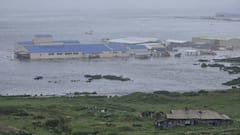Ancient Christian Monastery, Possibly Pre-Dating Islam, Unveiled On UAE Island
Carbon dating of samples collected from the Christian monastery's foundation on Siniyah Island off UAE coast found them to be dated between 534 & 656. This is the second such monastery to be found.

An ancient Christian monastery has been discovered in the United Arab Emirates (UAE), and officials have said it possibly pre-dates the years when Islam started to spread across the Arabian Peninsula. The monastery found on the Siniyah Island off the UAE coast gives a fresh peek into the history of early Christianity in this part of the world. Dating back nearly 1,400 years, this is the second such monastery to be found in the UAE.
“Today we...unveiled the discovery of UAE’s 2nd historical monastery dated between the 6th & 8th centuries on the Island of Siniyah in Umm Al Quwain,” UAE Minister for Culture and Youth Noura al-Kaabi posted on Twitter.
The two monasteries lost their existence as Islam started to grow more prevalent along the shores of the Persian Gulf and Christians gradually converted to the new faith, an Associated Press report said citing what scholars believe. Christians are now a minority across the Middle East.
According to the AP report, carbon dating of samples collected from the monastery’s foundation found them to be dated between 534 and 656. Prophet Muhammad was born around 570 and died in 632 after conquering Mecca in present-day Saudi Arabia.
The UAE today is a “melting pot of nations”, according to Timothy Power, an associate professor of archaeology at the UAE University, who helped investigate the Siniyah monastery.
“The fact that something similar was happening here a 1,000 years ago is really remarkable and this is a story that deserves to be told,” he was quoted as saying in the AP report.
Siniyah Island Where Christian Monastery Has Not Been The Only Historical Find
Siniyah Island has a series of sandbars that look like crooked fingers, according to the AP report. The Christian monastery was discovered on one of these. Siniyah means “flashing lights”, and the island could be called so due to the effect of the hot sun. The island shields the Khor al-Beida marshlands in Umm al-Quwain, located around 50 km northeast of Dubai along the Persian Gulf coast.
The floor plan of the monastery on Siniyah Island, viewed from above (see photo), suggests Christian worshippers prayed within a single-aisle church, the report said, adding that rooms within the structure appeared to hold a “baptismal font”, and also an oven to bake bread for communion rites. There might also have been an altar and an installation for communion wine, according to the report.
A second building has been found next to the monastery, and it has four rooms, likely around a courtyard. It could possibly have been the home of an abbot or even a bishop in the church.
Noura al-Kaabi, the culture minister, paid a visit to the site Thursday, along with Sheikh Majid bin Saud Al Mualla, chairman of the Umm al-Quwain’s tourism and archaeology department. The latter is also a son of the emirate’s ruler. The island is part of the ruling family’s holdings.
The dig, which is continuing at the site, was sponsored in part by the culture ministry, the AP report said.
Located just a few hundreds of meters away from the church can be found another set of ancient buildings, believed to be part of a pre-Islamic village.
Related Video
Indore Water Crisis: Contaminated Supply Causes Deaths, Authorities Face Severe Negligence Questions





































